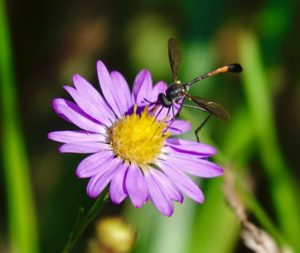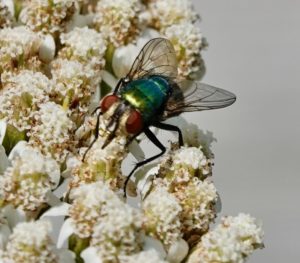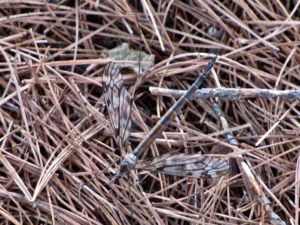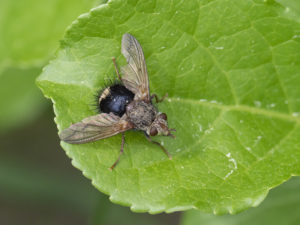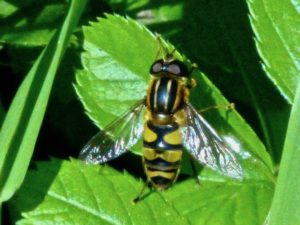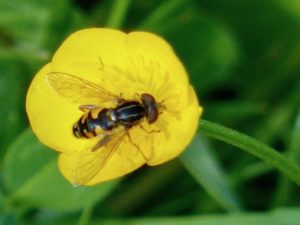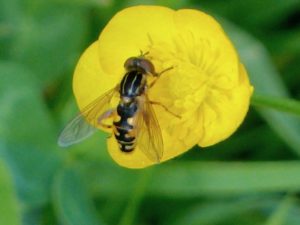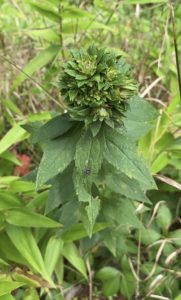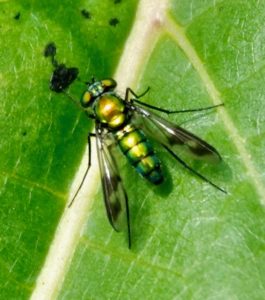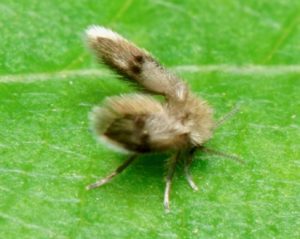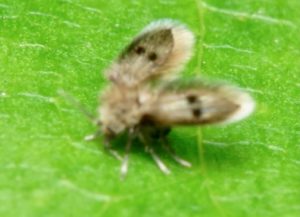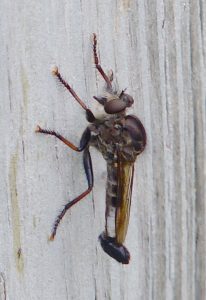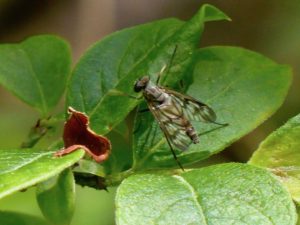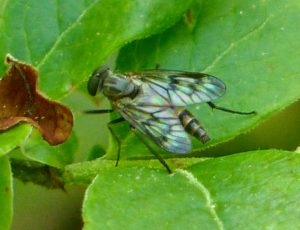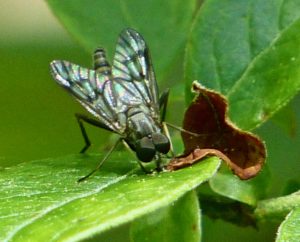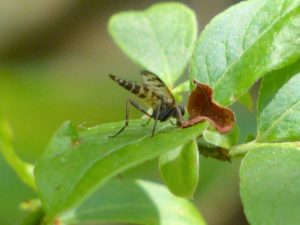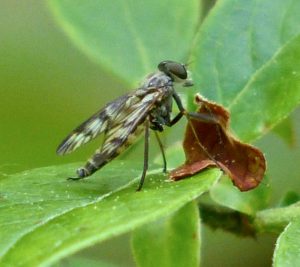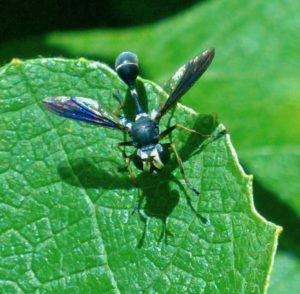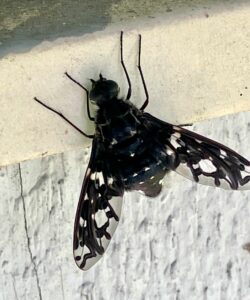Sightings – Flies
Observer: Paul Lauenstein
Observation Date: 9/4/20
Observation Time: 2:15 p.m.
Observation Location: Moose Hill Farm (TTOR)
Common Name: Bee fly
Scientific Name: Systropus macer
Comments: This fly looks like a wasp. It was feeding on a late purple aster blossom beside the dirt road under the power lines.
More Information: Forestry Images and Bugguide.net
Observer: Faith Berkland
Observation Date: 6/20/14
Observation Time: 10:30 a.m.
Observation Location: On one of the reflectors I have around my driveway.
Common Name: Brown Mantidfly
Scientific Name: Clineriella Brunnea
Comments: I first thought it was a praying mantis but none of the pictures showed one that small, or with the wasp-like abdomen. I decided to see if it was a type of wasp and voila! See this photo.
More Information: Wikipedia
Observer: Paul Lauenstein
Observation Date: 3/17/11
Observation Time: 3:10 p.m.
Observation Location: vernal pool near Bay Road
Common Name: Caddisfly Larva
Scientific Name: Order Trichoptera
Comments: Caddisfly larva are aquatic. They build a protective case of silk around themselves, incorporating debris for camouflage and protection. Their presence is indicative of good water quality. Adult caddis flies emerge en masse for just a few weeks. After emergence, they do not eat, but they mate and the females lay eggs. Caddisflies are a preferred food of trout.
More Information: Watersheds.org
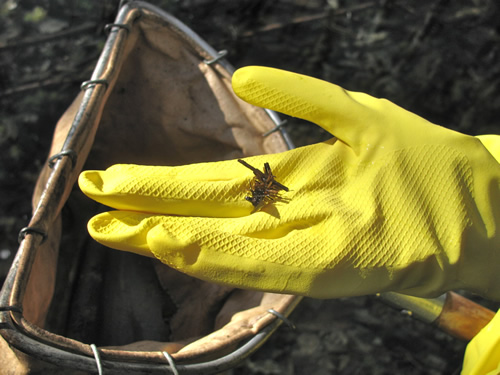
Observer: Paul Lauenstein
Observation Date: 7/5/21
Observation Time: 2:20 p.m.
Observation Location: Maskwonicut St. (on the bridge over Beaver Brook)
Common Name: Common Green Bottle Fly
Scientific Name: Lucilia sericata
Comments: The common green bottle fly (Lucilia sericata) is a blowfly found in most areas of the world and is the most well-known of the numerous green bottle fly species. Its body is slightly larger than a house fly, and has brilliant, metallic, blue-green or golden coloration with black markings. It has short, sparse, black bristles (setae) and three cross-grooves on the thorax. The wings are clear with light brown veins, and the legs and antennae are black.
The larvae of the fly may be used for maggot therapy, are commonly used in forensic entomology, and can be the cause of myiasis in livestock and pets.
More Information: Wikipedia
Observer: Paul Lauenstein
Observation Date: 5/26/10
Observation Time: 5:20 p.m.
Observation Location: Gavins Pond
Common Name: Crane Fly
Scientific Name: various
Comments: These insects look scary but they don’t bite.
More Information: Wikipedia
Observer: Paul Lauenstein
Observation Date: 7/13/13
Observation Time: 12:05 p.m.
Observation Location: Soccer parking area by Gavins Pond
Common Name: Dronefly
Scientific Name: Eristalis tenax
Comments: This fly looks like a drone honeybee—hence the name.
More Information: TrekNature
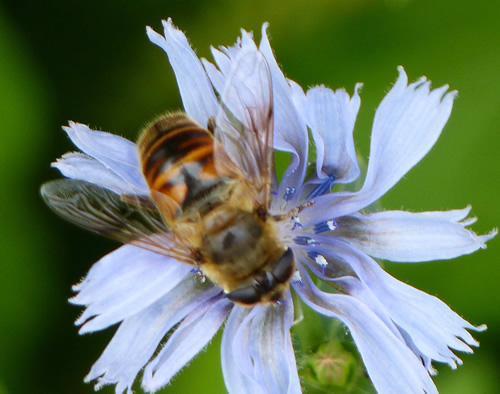
Observer: Josh Simons
Observation Date: 6/2/22
Observation Time: 3:00 p.m.
Observation Location: Moose Hill Wildlife Sanctuary
Common Name: Early Tachinid Fly
Scientific Name: Epalpus signifer
Comments: This specimen was identified with the Seek iOS app.
More Information: Wikipedia and Missoula Butterfly House and Insectarium
Observer: Paul Lauenstein
Observation Date: 5/23/18
Observation Time: 8:50 a.m.
Observation Location: Moose Hill Farm (TTOR)
Common Name: Flower Fly
Scientific Name: Helophilus fasciatus
Comments: Flower Flies (also known as “hover flies” because of their tendency to hover in mid-air for long periods), are especially interesting insects. They are overlooked by nearly everybody but farmers, who recognize them as one of the most important groups of insects beneficial to humans. They’re not only important pollinators, but they dispose of crop pests as carnivorous larvae. There are 15 genera in all, and hundreds of species.
More Information: NatureSearch
Observer: Paul Lauenstein
Observation Date: 5/27/19
Observation Time: 3:40 p.m.
Observation Location: Conservation land near Morse & Lakeview Streets.
Common Name: Flower Fly
Scientific Name: Helophilus fasciatus (family: Syrphidae)
Comments: Flower Flies (also known as “hover flies” because of their tendency to hover in mid-air for long periods), are especially interesting insects. They are overlooked by nearly everybody but farmers, who recognize them as one of the most important groups of insects beneficial to humans. They’re not only important pollinators, but they dispose of crop pests as carnivorous larvae. There are 15 genera in all, and hundreds of species.
More Information: North American Insects & Spiders
Observer: Josh Simons
Observation Date: 9/9/20
Observation Time: 11:00 a.m.
Observation Location: Moose Hill area
Common Name: Goldrenrod Bunch Gall Midge
Scientific Name: Rhopalomyia solidaginis
Comments: This peculiar insect makes a gall on goldenrod.
More Information: iNaturalist
Observer: Paul Lauenstein
Observation Date: 7/5/21
Observation Time: 2:00 p.m.
Observation Location: Maskwonicut St. near Beaver Brook
Common Name: Long-legged fly
Scientific Name: Condylostylus patibulatus
Comments: Metallic green long-legged flies are typically found near water. I encountered this one hopping from leaf to leaf on vegetation growing on the bridge over Beaver Brook. Adult flies are predaceous on mites, aphids, booklice, thrips, flies, silverfish, small caterpillars and other small insects.
More Information: Edible San Marcos
Observer: Gaurav Shah
Observation Date: 7/1/23
Observation Time: 4:00 p.m.
Observation Location: trail off Billings St.
Common Name: Moth Fly or Drain Fly
Scientific Name: Family Psychodidae, possibly genus Pericoma
Comments: There are many species of flies in the family Psychodidae. Some are called “drain flies” because they thrive in the drains of sinks and commonly infest bathrooms. Other species in this family are called “moth flies” because they have fuzzy bodies and feathery antennae that are characteristic of many species of moths. The fact that this specimen was observed in the woods and not in a bathroom suggests that it is a type of moth fly.
More Information: Missouri Dept. of Conservation and Wikipedia
Observer: Paul Lauenstein
Observation Date: 7/18/15
Observation Time: 5:10 p.m.
Observation Location: Gavins Pond Dam
Common Name: Robber fly (male)
Scientific Name: Efferia apicalis
Comments: Robber flies of the genus Efferia are small to large-sized robber flies (10–40 mm) with a distinctly different shape of the posterior end of the abdomen in males versus females. Females have a short or long ovipositor that is hairless and short conical to slender wedge-shaped, its color is usually glossy black. Males (such as the one pictured below) have a “helicopter tail” with glossy black claspers that are covered in hairs, forming part of a complex genital structure (the combined epandrium and hypandrium) that is clearly larger than the abdominal segments and is oriented diagonally to vertically upwards relative to the main body axis.
As is typical for robber flies, adult Efferia are ambush predators, taking off from a resting position on the ground or on a branch to intercept other flying insects in mid-air.
More Information: Wikipedia
Observer: Paul Lauenstein
Observation Date: 5/27/19
Observation Time: 1:00 p.m.
Observation Location: Conservation land near Morse & Lakeview
Common Name: Snipe Fly
Scientific Name: Rhagio mystaceus
Comments: Also known as a down-looker fly. Two of the photos show why.
More Information: Wikipedia
Observer: Paul Lauenstein
Observation Date: 7/7/18
Observation Time: 1:45 p.m.
Observation Location: Moose Hill Farm (TTOR)
Common Name: Thick-headed Fly
Scientific Name: Physocephala tibialis
Comments: This family of flies is a parasite of solitary bees, and sometimes wasps. The female grabs the host while in flight and forces an egg between the bee’s abdominal segments.
More Information: NatureSearch
Observer: Paul Lauenstein
Observation Date: 8/14/25
Observation Time: 12:45 p.m.
Observation Location: Gavins Pond Rd.
Common Name: Tiger Bee Fly
Scientific Name: Xenox tigrinus
Comments: The tiger bee fly is a beneficial insect because it preys on the larvae of carpenter bees. Carpenter bees chew tunnels in wood, and can damage your house.
If you happen to have a carbenter bee infestation, you can scare them away by hanging a fake hornets nest where they can see it. You can buy fake hornets nests at Amazon.
More Information: Georgia Dept. of Natural Resources and Wikipedia

